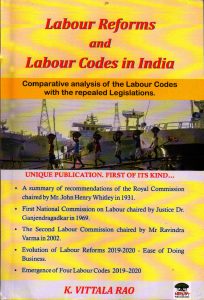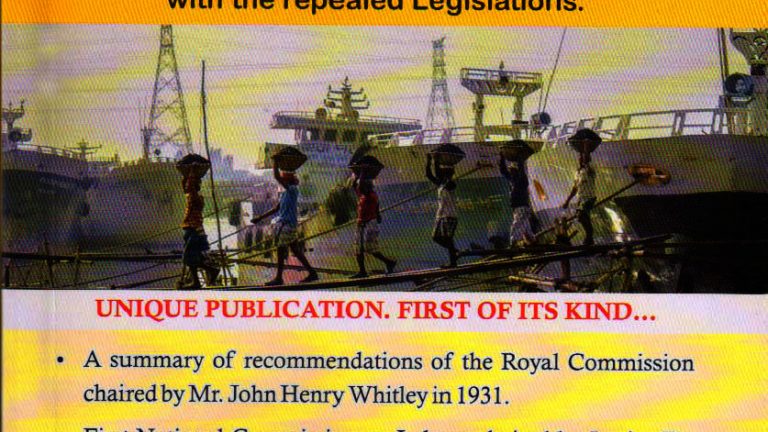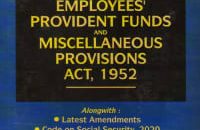
Labour reform is one of the most sensitising actions by the treasury bench that often knowingly or unknowingly is opposed not only by the opposition bench but often by the trade union outfit of the treasury bench. The fall out is obvious…once bitten, twice shy to implement. The Indian trade union movement is much more aligned with political ideology rather than syncing with the socio-economic reality. Within the prevailing geopolitical scape of the country often the actual reform takes the back seat. In a country even the mildest intervention attracts huge criticism in public platform and thus the ideas of reform are often shelved helping none other than the conflicting political outfits aiming for retaining and/or capturing support base from the industrial population. There is a growing un-unionised culture of certain knowledge based industries. The term “Industrial relations” has its new avatar and is regarded as “Employee Relations” for them. But when we talk about the labour intensive manufacturing industry, the hand holding of the working class in a factory environment is still of much relevance. Drafting an HR policy or designing a new performance management system is fine for a newly appointed executive and deployed at corporate service but the ultimate outcome depends on how the perceptions of working hands are aligned with those policies and practices. There has to be ‘buy-in’ of those thought processes from the internal customers of the industrial establishment. If there is a gap; the un-unionised new age industries would experience scaling up of attrition; and for conventional sectors having unionised workforce it would be dharna, go-slow and strike; prompted by employees. The lack of understanding as well as inability to communicate the business realities and interpreting legal ecosystem could trigger the employer to explore lay-off and lock out for two principal sets of industry. Here lies the major Business Partner roles of HR. They should engage themselves as the preventive maintenance manager ensuring industrial peace and keeping the employees engaged and loyal for the organisations. They are both employers’ and employees’ advocates and just not there to outsource the role to some retainer when conflict crops up. It is imperative for HR professionals to have a holistic knowledge of employment related laws of the land. It not only helps in bridging the gap of perspectives of two major stakeholders of the industry but also ensures effective supervisions of the retainer, if at all required to engage for specialist advice and interpretations. This is the reason why in the corporate parlance it is often whispered that outsourcing leads to more insourcing of processes!
A general understanding of global labour practice has become a need of hour as a practitioner’s skill for the growing numbers of MNCs and visionary Start-ups. The HRs are from different streams at their graduate levels thus the student community and practitioners need a touch of knowledge of the legacy and advancement of employer-employee relations of the country as a whole. The more they know about the background of the labour reforms vis-a-vis directional changes of employment related laws, it is good for professional enrichment and delivery. The book of Sri K. Vittala Rao on “Labour Reforms and Labour Codes in India” (ISBN: 978-93-84262-76-1) published by Niruta Publications of Bengaluru is a right fit for this segment of the professionals aiming a purposeful career in HR. The 450 page enriched handbook comprises 2 (two) fundamental parts; Part I contains Labour reforms and Part II contains the recently promulgated 4 (four) Labour Codes. The ‘labour’ as a subject is from concurrent list under the constitution of India, thus having say for both the Central and State Government for enactment of legislations with certain matters are being reserved therein for the Central. The implementation of 4 (four) labour codes slowly but surely would become operative for the states to remain competitively advanced over others. But the past journey of labour reforms is equally challenging to note. The author’s effort to cover them in a nutshell comprising 4 (four) chapters is interesting and praiseworthy. It is knowledge enhanced by a quick reading of the Report of the Royal Commission on Labour (1931), First National Commission on Labour (1969), Second National Commission on labour (2002) and finally a comparative short analysis of all 3 (three) of them. Due to its currency and relevancy the author has given emphasis on Second National Commission by having detailed discussions through 10 (ten) chapters namely Terms of Reference, Introductory Review, Industrial Development & Progress after Independence, Impact of Globalisation, Approach to Review of Laws, Review of Laws, Unorganised Sector, Social Security, Women & Children and finally Skill Development. The designing of the chapters state the depth of subject knowledge that the honourable author acquired during his 5 (five) decades of professional journey in the field of corporate, consulting and academia as well as his eagerness to pass on the baton to the future generation. Other than the practitioners, the academia would surely find it useful for quick referencing. A fantastic example of organised “Knowledge Management” shown by the author.
It is often difficult to cover 100 years (Workmen’s Compensation act came into force way back 1923) of movement of labour reforms in a few pages and thus there is always scope of review in the future editions based on the feedback of readers, especially from industry veterans and academia but without increasing volume of the handbook. I would suggest the author consider chronologically ordered bullet points of this 100 years of movement with special mention of the oldest Steel manufacturers of India. As a management practitioner we all know that even before the majority of employee laws came into force in India, the spirit of those laws were in practice by them, much ahead of time. As a management practitioner we all know that even before the majority of employee laws came into force in India, the spirit of those laws were in practice in Tata, much ahead of times. The journey also witnessed several industrial violence, not only the last decade incidence of the Manesar plant of the biggest car makers of the country. A few pages covering concise accounts of such reported cases would be value-adding for referencing and understanding the seriousness and delicateness of this otherwise noble profession of HR. In India likewise the car makers there are many organizations that turned into a complete MNC organization having a baseline of government control set up, and mention of the transition journey of people therein shall definitely create interests in professional learning. The impact of reforms in the un-unionised service sector is an area to be watched closely. The effect of employee relations is often limited to the organisation but issues that trigger effect to entire value chain of the industry requires much more sensitivity, and negotiation skills armed with deep understanding of industrial relations and business reality by the HR while handling. The new age industry practicing “Employee Relations” is not beyond it. We have a ready example of current relevance: the moment one of the Top-3 Tech company introduced lay-off the other companies started following the trends. Then there is Industrial relations effect on the “Side Industry”. Just like political affiliation of the trade union equally important are the roles of Industry house, Professional bodies and NGOs for sustainable industrial peace. A brief narrative on the success and failure of these stakeholders, their policy advocacy and its impact on regulators would help us in 360° learning.
Finally, limiting ourselves is only our choice. As a professional we need not to be self-obsessed; rather than bragging and pretending for professional accomplishment with limitless social media posts it is perhaps worthwhile to spend Rs. 500/- for such handbooks and keep it with self 24*7 as a professional partner. Over the years we went through the grind of labour reforms, without its harnessing, all else is skimming.
I should be thankful to the publisher “Niruta Publications” for bringing out this quality paper, print, layout and binding professional publications kindly foreworded by Sri S N Murthy, eminent Senior Advocate of Bengaluru, a domain expert. It is a testimony of its own.
(Reviewed by Indranil Banerjee, Kolkata)
Author : K. Vittala Rao
Publisher : Niruta Publications, No. 326, 2nd Floor, Opp. Canara Bank, Near Dr. AIT College, Kengunte, Mallathahalli, Bengaluru-560 056
Price : Rs. 500/-
Website: www.nirutapublications.org, www.mhrspl.com
Stay connected with us on social media platform for instant update click here to join our LinkedIn, Twitter & Facebook
































